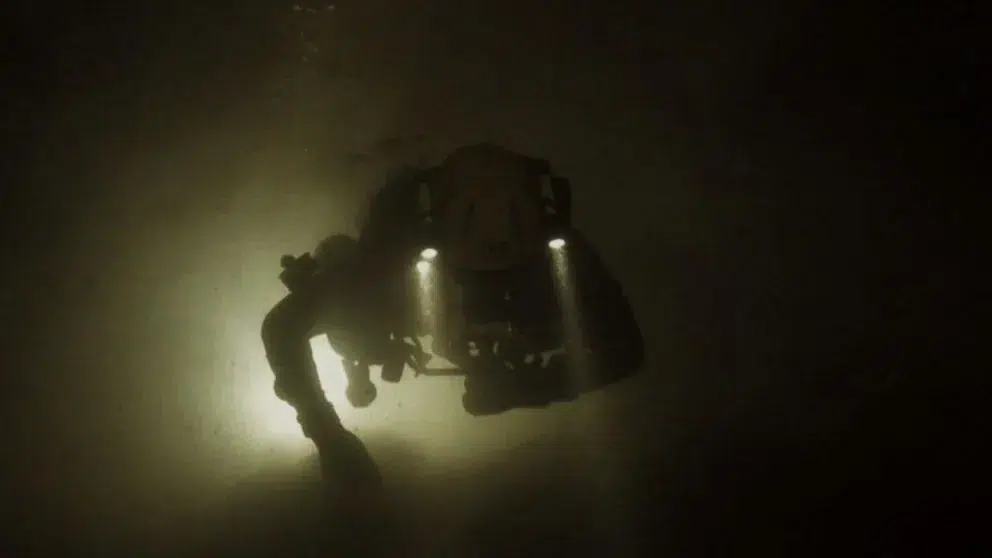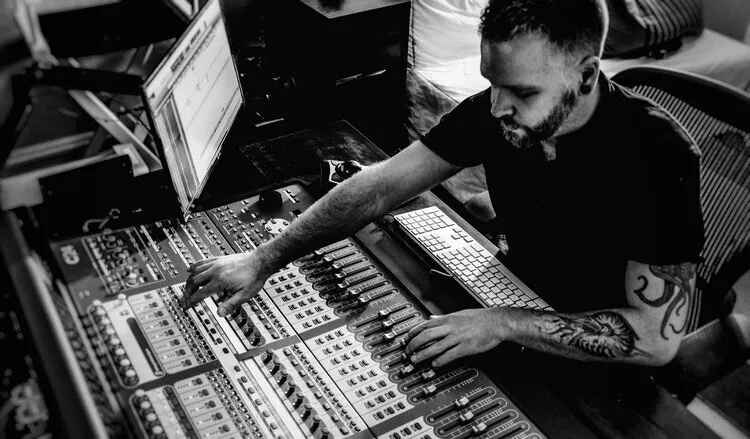Painting a Picture With Sound

Consider this scenario. A diver plunges into the depths of murky waters, he struggles to make his way in the darkness, unsure of what lies ahead. He’s strained by the sedated body he carries with him as he swims through the twisting and turning terrain of a cave. The chance of survival is bleak.
How do you convey this image of being suspended in a vast void to someone listening to this story?
For Pedro Mendes, one of the showrunners at Pacific Content, the answer lies in an old trick of the radio trade. You rely on sound to paint a mental image.
That’s exactly what Mendes did when thinking through an episode of Teamistry, a podcast by Atlassian, about the famous Thai cave rescue that took place in 2018.
“I remember telling our sound designer that I wanted it to be a cinematic experience,” says Mendes. “I wanted listeners to feel what the divers felt like. I wanted the show to sound claustrophobic, I wanted people to feel like they were trapped underwater.”
Before joining Pacific Content, Mendes had thought a lot about creating images and experiences through sound. He’d spent more than a decade as an audio producer, host, and editor at CBC Radio, and worked as a studio director for Penguin Audio Books.
During his time at CBC Radio, Mendes had worked with celebrated radio documentary maker Steve Wadhams. Now retired, Wadhams was the first person to recount that old radio adage about sound being the most visual medium to Mendes.

“I did not understand what he meant when he first said it; his words did not make sense to me,” says Mendes, grinning. He sports a crisp white shirt to herald the onslaught of summer, and COVID-glory locks for a quick afternoon chat over Zoom. Also an authority on classic men’s style, Mendes is known for his sharp sartorial sense, even when the video is off.
“But then [Wadhams] explained that when you are listening to audio — because there are no other visuals — your mind is painting a picture inside your head…. And what’s so powerful about it is that they are making it. [The listener has] actually contributed to the experience, they are active participants in creating a scene.
“That’s why sound is more visual. The experience that an individual is having— it’s something they have created. It’s extremely vivid and personal. And chances are that it will stick to them, versus seeing something on a screen, which you are passive to.”
For people working in audio storytelling, using sound to create mental images is a powerful tool. It allows you to think beyond simply communicating information; instead of using sound to simply illustrate, for example, you can also use it to narrate.
“There was another great line Wadhams had, and he heard it from another doc maker: Narration if necessary, but not necessarily narration,” says Mendes. “The gold standard of audio storytelling is to have sound tell a story without you having to use words.”
The Teamistry episode on the Thai cave rescue is an example of keeping that gold standard in mind. The premise of the show is to present narrative documentaries about teamwork that has changed industries, the world, or even individual lives, proving that when people work together they can achieve more than they ever thought possible.
Given the extraordinary circumstances around it, the story had been well-documented. A dozen teenagers and their soccer coach had gone exploring in a cave in Thailand’s Chiang Rai province and gotten trapped. Thousands of people who had never worked with each other before this incident came together to orchestrate a remarkable rescue.
“The story we heard in the news was about this massive international effort to rescue these kids. What we wanted to do was show you what that effort looked like. There were local residents. Thai navy seal divers. American army experts. And, people from around the world,” says Mendes. “Not only were we telling, here’s what happened — but how did this happen. And what sort of inspiration other people can take from how these teams figured out how to do it.”
Teamistry had managed to get interviews from many of the key players of the story — Narongsak Osottanakorn, the former Governor of Chiang Rai province; Lt. Col Charles Hodges of the U. S. Air Force; Richard Harris, an anesthesiologist and diver from Australia; and Richard Llyod Parry, Asia Editor of The Times of London, who had reported on-the-ground.
Now came the fun part — how do you incorporate sound into their narratives. Mendes was keen to strike a balance between illustrating what was said and allowing sound to tell the story.
“There is a tendency to [narrate] and then have the sound come in. Ultimately it comes down to having trust in the listener,” he adds.
Sound designer Chris Clark remembers getting notes from Mendes about wanting to have a sense of claustrophobia and unease, and the atmospherics of an action/thriller movie. The prospect of using music and sound effects to achieve that “you were there, kind of vibe” was exciting, he says.
“Having cave reverb on stuff. All the scuba sounds I tried to keep in stereo — so instead of having effects in the background, you felt like you were there underwater.”
It was all designed to make listeners feel as if they were in the situation themselves, and as stressed out as the people on the rescue mission.
Besides using foley sounds to illustrate specific scenes, such as when divers were gearing up to go on the rescue mission, Clark used some sound effects more metaphorically. As you hear the team’s descriptions of the task at hand, you occasionally hear the sound of breathing from an oxygen tank in the background.
Using the rhythmic breathing as a backdrop, Clark says he was able to illustrate high stakes moments by “bringing up sound and speeding up the velocity of the bubbles, and the breaths — kind of like a heartbeat at resting pace, and ramping up as things get more intense.”

It works. As you listen, you can feel the tension building in your body, as your mind conjures up images of a dank cave. Clark wasn’t sure what those Thai caves exactly sounded like, but he relied on his background doing sound design for movies.
“Caves always have a dripping sound, they are always super echo-ey. I tried to not make it too cheesy…. I also put in a drone, which is a room tone ambiance that has a rumble to it. Apparently, when you have it going for a long time, it makes people feel uneasy,” he says.
For Mendes, that ultimately is the beauty of using sound for visual effects — the ability to transport a listener.
“I can take people through time. I can take them to any place in the world, places that do not exist. I can take people there through a few chosen words, and a few chosen little pieces of sound.”
Listen to “Mission Impossible: The Thai Cave Rescue,” from Teamistry.
Sign up for the Pacific Content Newsletter: audio strategy, analysis, and insight in your inbox.
